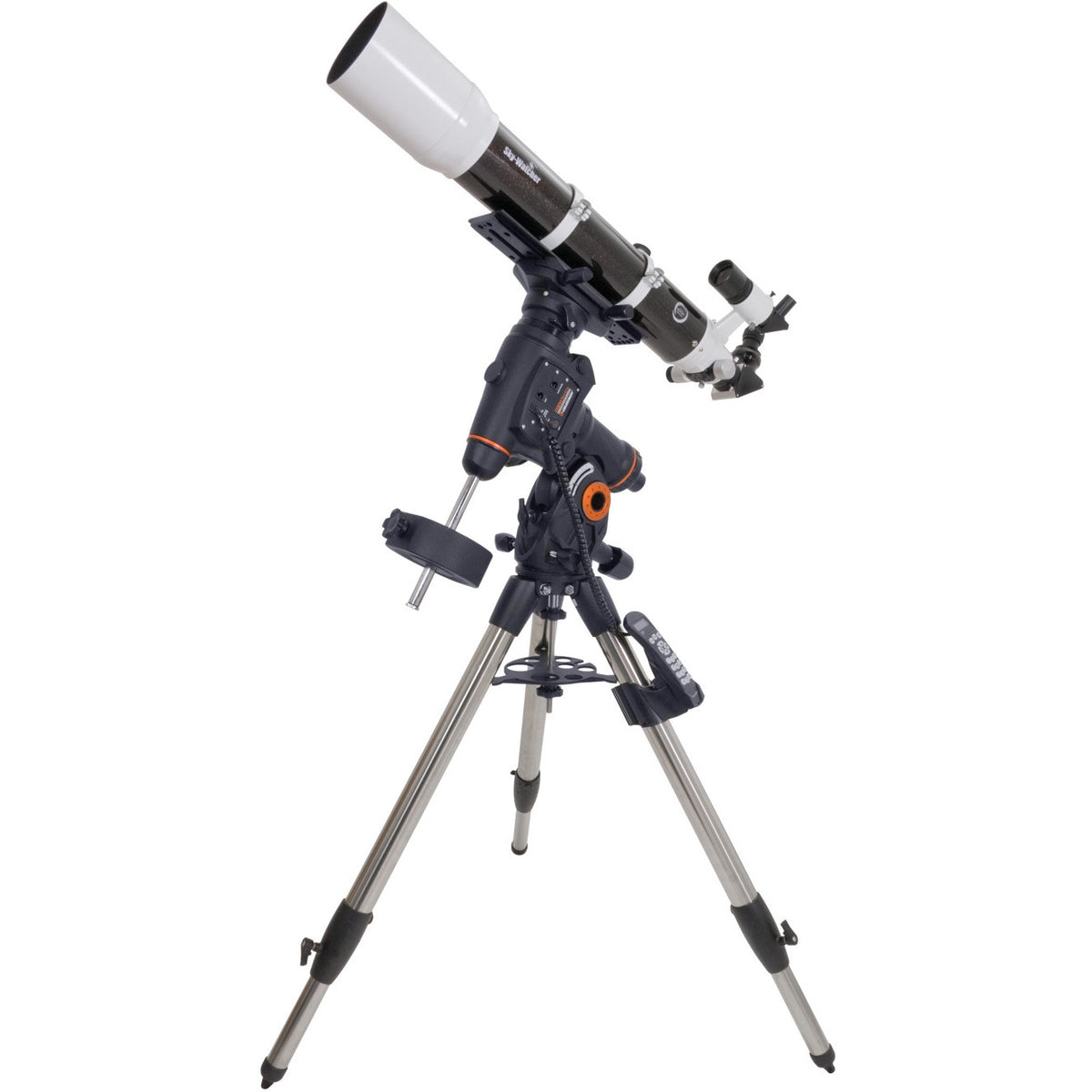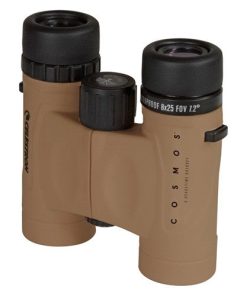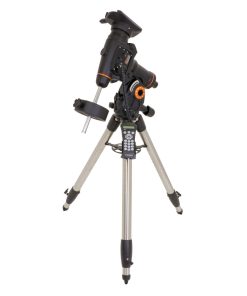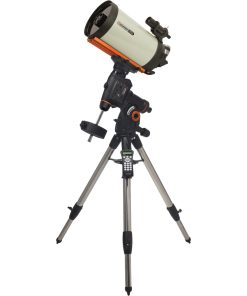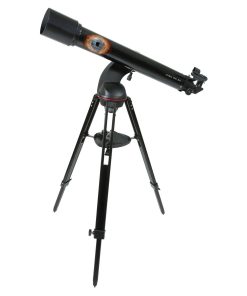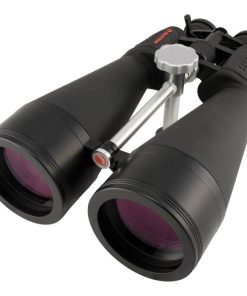Sky-Watcher PRO 120ED APO Refractor Telescope with CGEM Mount – S11200 Sky-Watcher
$ 2.799,00 $ 699,75
SKY-WATCHER PRO 120ED APO REFRACTOR: Serious Amateurs will Love the SW 120mm ED-APO Refractor
Sky-Watcher high-performance ED-APO refractors offer premium optical performance for the discriminating amateur astronomer. Refractors are coveted for their superb contrast, high-definition and coal-black sky background that make stars appear like diamonds imbedded in black velvet. SW APO refractors utilize the most modern optical glasses and fabricating techniques to deliver the ultimate in high-fidelity astronomical imaging. Subtle details pop as never seen before in telescopes of lesser optical capability.
Observing with the Sky-Watcher PRO 120ED APO Refractor
The additional aperture compared to a 100 mm diameter lens provides a dramatic increase in resolution and a heighten sense of seeing lunar and planetary surface phenomenon in seemingly 3D high-definition.
Touring the Moon…the rugged Southern Highlands of the lunar surface are rich in craters. To the southeast, the famous crater Theophilus is 65 miles across. The raised triple-peaked central area is striking to observe in your SW 120ED. The crater has massive walls and the basin is 14,000 feet deep. One of the southernmost craters, Clavius, is a very large crater 145 miles across. It is located south of Tycho. In this same area can be found craters Maginus and Longomotanus which are also very worthy of exploration. To the north, the young crater Tycho dominates the southern lunar landscape. Named after the famous Danish astronomer Tycho Brahe, it is a spectacular sight with very high-rimmed walls. Your SW120ED will provide an impressive view. North of Tycho appearing brightly in a basin is the famous Rupes Recta (the Straight Wall), an 800 foot mountain that is a “must see” for amateur astronomers. Your SW 120ED will show it clearly and sharply the way you want to see it. On the north end of Mare Nubium, almost on the lunar N-S and E-W center line can be found 3 craters grouped together: Arzachel a young impact crater 60 miles across and 13,000 feet deep shows a terraced structure and a system of channel-like narrow depressions in its basin called “rilles”. Nearby are Alphonsus, a 70 mile wide crater, and Ptolemaus a prominent ancient crater 90 miles across with a heavily worn dark interior. The Earth’s Moon offers a treasure trove of fascinating detail to explore with your SW 120ED-APO EQ5 PRO. We have only featured a relative few examples of what is available. The views you will experience are so clear and sharp it might just feel like a veritable space-walk.
Planets are spectacular…the inner solar-system presents the colorful rusty-red planet Mars. Mars is a challenge for amateur astronomers, but your SW 120ED will show some very interesting detail. Olympus Mons, a volcanic crater 375-miles across and 16-miles high, is just one of the quests your capable SW120ED can tackle. Nirgal Vallis is a channel 600 miles long that responds well to the razor sharp contrast provided by the SW 120ED. The Grand Canyon of Mars, Valles Mariners, dwarfs that of our Earth’s Grand Canyon, but it still requires superb optics to view even though it is 150 miles wide and 4 miles deep. When prominent, the gleaming white Mars’ polar cap is in stark contrast to the redish-orange surface landscape of the rest of the planet. The SW 120ED will show you this detail like you want to see it. The gas giant Jupiter displays its swirling equatorial bands in high-definition with festoons and tonality within the bands. With regular observation, you will be able to follow storms and disturbances cross the planet in the southern equatorial band. Saturn’s storied surface phenomenon is simply stunning. View the rings and clearly see Cassini’s Division and cloud belts across its equator.
Wonders of Deep-Space…beyond the solar-system hunt down double stars like Epsilon Lyrae, and the “double-double” in Lyra. A 120 mm ED-APO refractor will provide a crisp well defined image on par with up to a 7″ reflector. Always a star-party favorite, the beautiful double Alberio located in the tail of Cygnus is sensational. Alberio appears like a gold sparkler and its companion looks like a blue-green sparkler. It is a perfect object to view with your SW 120ED. Algol, an eclipsing variable star, sometimes called the “winking eye” fluctuates in brightness and is a suitable subject for the SW 120ED. Aldebaran, a beautiful orange giant in the Constellation Taurus is a delightful sight to view with the SW 120ED. In the eastern corner of Constellation Orion, Rigel, a bright blue double has a blue-green companion that requires excellent optics to see, a worthy subject for the SW 120ED. Tight globular star clusters like M13 in the Constellation Hercules appear like a beehive of crisp stellar pin points circling the central core, star upon thousands of stars. Compact globular star clusters lend themselves well to a refractor. M5 is a worthy object for viewing. M92, in the Constellation Hercules, is very compact globular with a bright core. It is a great object to view with the SW 120ED. M4, M10 and many other globular clusters can be seen well with the SW 120ED-APO refractor. The bright central cores of prominent nebulae can be seen and the brightest stars can be observed illuminating the glowing nebulosity which appears as ghostly apparitions.
The superb capabilities of the SW 120ED provide performance on a par with a reflector of perhaps up to 7″ in diameter on lunar, planetary, double-stars, globular star clusters, and depending on your ranking of unobstructed high-contrast as a necessary attribute, even the brighter nebulae may look better to you in a SW 120ED. These objects will stand out in bold relief contrasted against a very dark velvet-black sky background. Many advanced amateur astronomers feel the ED-APO experience is astronomy’s richest.
As an astrograph, the SW PRO 120ED APO performs superbly delivering crisp, high-fidelity imaging of planetary, lunar and aperture appropriate deep-space phenomenon.
Refractors – the Ultimate Imaging Instruments
In a given aperture size, refractors will always exhibit sharper images than other optical designs because the refractor concentrates more light into the central airy-disk and first diffraction rings. There is no diffraction pattern interference caused by a diagonal mirror or secondary mirror being suspended in the optical path (central obstruction) as is the case with reflectors.
Sky-Watcher ED-APOs – the Ultimate Refractors
Sky-Watcher ED-APO refractors provide the finest images obtainable – bar none – in their design class. If you are on a quest for the ultimate in pristine, near textbook-perfect astronomical imaging, look no further! Sky-Watcher ED apochromatic refractors deliver dramatic coal-black skies and faithful, contrast-rich views of planetary and deep-space phenomenon that are second to none. Sky-Watcher ED-APO refractors are the logical choice as an investment in advanced instrumentation for exceptional viewing or photography.
Virtually Eliminates Residual Chromatic Aberration
The Sky-Watcher ED-APO design assures virtual elimination of residual “false color” (i.e. chromatic aberration) normally present in 2-element achromatic lens designs which utilize standard crown and flint glasses.
Sky-Watcher APO refractors utilize the finest extra-low dispersion (ED) glass available, FPL-53. This results in the best color correction for an ED doublet lens.
Schott Glass Used in Selected Models for Crown Element
Select models of ED-APO refractors will benefit from the inclusion of Schott glass being used for the positive front Crown element in the objective. Schott is the recognized world leader in glass utilized for precision optical lens systems, including medical instrumentation and famous-brand camera lenses. While Schott glass is only used in selected models, all other models utilize top-quality, Grade-A glass from perhaps less famous but, nonetheless, highly respected, high-quality glass manufacturers.
Pride and Perfection in Optical Manufacturing
Every lens element is individually inspected for purity and absence of striae and other image-degrading imperfections. Every lens is pitched polished to exacting standards of optical fabrication and performance by highly skilled opticians utilizing state-of-the-art methodology and rigidly controlled optical testing procedures. The result is high-quality, diffraction-limited optics performing to the theoretical limits of their respective aperture sizes. All lenses are uniformly air-spaced in their cell housings.
Sky-Watcher offers one of the most extensive lines of ED-APOCHROMATIC refractors in the world. Using only the finest fabrication materials available, Sky-Watcher APO refractors are manufactured to painstakingly rigorous, exacting standards of optical and mechanical quality to insure the amateur astronomer peak performance and a great experience each and every time a Sky-Watcher ED-APO is taken into the field. We know the amateur astronomer has very high expectations regarding astronomical equipment purchases. Sky-Watcher has been delivering consistent satisfaction for over a decade.
Metallic High-Transmission Lens Coatings
Each air-to-glass lens surface has exotic anti-reflection metallic coatings applied to ensure optimum light through-put. The proprietary Sky-Watcher “Metallic High-Transmission Coatings” (MHC) are the finest photon anti-rejection coatings in their class.
Light-Baffled Optical Systems
The objective lens cell is light-baffled to reject stray, unfocused light. The draw tube is likewise baffled to insure optimum contrast. The tube interior is flat blackened to help prevent unfocused internal light reflections from reaching the focal plane.
Precision 2″ Crayford-style Focuser is Standard
Optical focus is achieved by means of a mechanically ultra-smooth, backlash-free, precision 2″ Crayford-style focuser-assembly. This focuser offers 2-speed fine and ultra-fine focusing adjustments.
Tube Materials
The optical tube material is aluminum, powder-coated reflective gloss black with gold fleck accent. The front and back cells are cast-aluminum painted white or black.
Telescope Tube Attachment Hardware:
The Sky-Watcher APO optical tubes come with attachment hardware that allows them to be securely fastened to the SW EQ5P mount. The quick-release tube rings provided with SW ED-APO models 80ED, 100ED and 120ED are cast-aluminum, painted white.
Included Components for Selected Models
SW PRO ED-APO models are also supplied with a RA 8x50mm viewfinder with bracket; 2″ dielectric diagonal; two 1.25″ LE (Long Eye Relief) eyepieces (LE20mm and LE5mm); 1.25″ focuser adaptor; and tube ring attachment hardware for mounting to the Sky-Watcher EQ5PRO Mount (or other compatible mount) and a foam lined aluminum carry/ storage cases for the optical tube and accessories is included.
FEATURES
- 120 mm APO Refractor with ED Schott glass
- Holds a maximum instrument capacity of 40 lbs
- 900 mm focal length (f/7.5)
- CGEM Computerized Equatorial Mount
- Dual-speed 2″ Crayford-type focuser with 1.25″ adaptor
- Ultra sturdy 2″ steel tripod with Accessory Tray
- 40,000 object database with over 100 user-definable objects and expanded information on over 200 objects
- 20 mm and 5 mm 1.25
- Proven NexStar computer control technology
- 8×50 RA viewfinder
- Flash upgradeable hand control software and motor control units for downloading product updates over the Internet
- 2″ dielectric diagonal
- New All-star Polar alignment uses any bright star for a quick and accurate Polar alignment
- Tube-ring attachment hardware
- Software Features include: Mount Calibration, Database Filter Limits, Hibernate, five Alignment Procedures, and user-defined slew limits
- Aluminum carry case
- Custom database lists of all the most famous deep-sky objects by name and catalog number; the most beautiful double, triple and quadruple stars; variable stars; solar system objects and asterisms
- Permanent Programmable Periodic Error Correction (PEC) – corrects for periodic tracking errors inherent to all worm drives
- Steel worm gear and 90 mm pitch diameter brass worm wheel
- Drive Motors – Low Cog DC Servo motor with integrated optical encoders offer smooth, quiet operation and long life. The motor armatures are skewed to minimize cogging which is required for low speed tracking.
- Internal Cable wiring for trouble-free setup and transportation
- Designated six-pin RJ-12 modular jack, ST-4 compatible guide port
- Autoguide port and Auxiliary ports located on the electronic plate for long exposure astrophotography
- Double line, 16-character Liquid Crystal Display Hand Control with backlit LED buttons for easy operation of goto features
- RS-232 communication port on hand control to control the telescope via a personal computer
- Includes NexRemote telescope control software, for advanced control of your telescope via computer
- Precision machined 40 mm diameter steel Polar shafts supported by multiple tapered roller bearings and ball bearings
- GPS-compatible with optional SkySync GPS Accessory
Quick Shipping and Professional Packaging
Due to our longstanding partnership with UPS FedEx DHL as well as other major international carriers, we are able to provide various shipping options. Our warehouse personnel are well trained and will be able to pack your goods in accordance with the exact and precise specifications. Your goods are thoroughly checked and securely secured prior to shipment. Everyday we deliver hundreds of packages to our customers from all over the world. Our determination to be the biggest online retailer in the world is shown by this. The warehouses are located situated in Europe in the same way as they are in the USA.
Note: Orders containing multiple items will have a separate processing period for each item.
We will carefully examine all products before they are shipped. Today, the majority of orders will be delivered within 48 hours. The delivery time will be between 3-7 working days.
Returns
We don't manage the stock at our warehouse and factory. The actual inventory may fluctuate at any time. It's possible that you may not receive your order once it's been placed.
Our policy is for 30 days. We are unable to return or exchange your purchase after 30 days since the purchase.
In order for your item to be eligible for return the item must not be opened and in the condition you received it. It must also remain in the original packaging.
Related products
Discontinued
Discontinued
Discontinued
Discontinued
Discontinued
Baader Planetarium 2 Inch Steeltrack Crayford Focuser for Refractor Telescopes – BDS-RT Baader
Discontinued
Discontinued
Discontinued
Discontinued
Baader Planetarium SteelDrive Focusing System for Baader Steeltrack Focusers – FOC-DRV Baader
